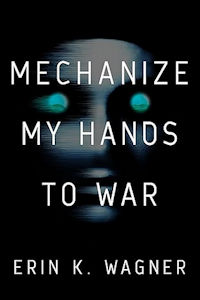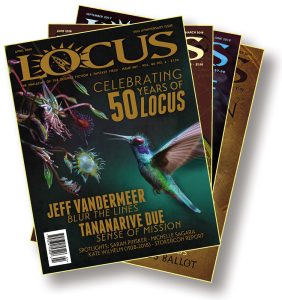City of Dancing Gargoyles by Tara Campbell: Review by Ian Mond
 City of Dancing Gargoyles, Tara Campbell (Santa Fe Writers Project 978-1-95163-139-0, $16.95, 280pp, tp) September 2024.
City of Dancing Gargoyles, Tara Campbell (Santa Fe Writers Project 978-1-95163-139-0, $16.95, 280pp, tp) September 2024.
What struck me about Tara Campbell’s 2019 collection, Midnight at the Organporium, was the breadth of her imagination and the way she switched between surrealism, revisionist fairytales, and horror. Her story ‘‘Speculum Crede’’ about a very odd work picnic (an understatement) still makes me smile. Campbell’s second novel, City of Dancing Gargoyles is a magnificent, postapocalyptic buffet of weird magic, unexpected friendships, and talking gargoyles that brings that vivid, eclectic, kaleidoscopic imagination to bear.
Set a century in the future, the West Coast of America has been irrevocably transformed by the government’s testing of alchemic weapons. Towns in Oregon, Nevada, and California are populated with gun-toting trees, falling magicians, and floating wolves. In the southwest, two chatty gargoyles, M & E, are planning to leave their parched town – they require water to survive – for the fabled ‘‘City of Dancing Gargoyles.’’ On their journey, the stony gargoyles encounter mother and daughter team Rose and Dolores Baker, fleeing their Californian town from the sparks and flames caused by a flight of kissing dragons. Running alongside the quartet’s quest for somewhere safe (or safer) to live, are the emails from two researchers, Meena and Joseph, sent by The Annals of Alchemical Changes to observe and chronicle the impossible landscape. Their mission is fraught with danger with little to no idea what or who they might confront.
City of Dancing Gargoyles is ostensibly a mosaic novel, a set of linked short stories with a framing device: M, E, and the Baker’s search for a home. It works beautifully. We get the narrative satisfaction of an overarching story with a series of vignettes that showcase the sheer weirdness of this new America – or at least the West Coast (it’s never made clear whether alchemical changes are a nationwide phenomenon). The reports, extracts from interviews, monologues or observations made by the researchers are astonishing flights of fancy. Not a single vignette is a throwaway idea or a cute thought experiment quickly forgotten. They all fizz with possibility, speaking to our capacity to accommodate and embrace the impossible.
If I’m not throwing examples at you, it’s because there’s an anticipatory delight in not knowing what’s coming next. Having said that, it would be a dereliction of my reviewing duties if I didn’t give you a taste. We visit the City of Fretting Books, where amongst the redwood forests, remainders that were never pulped but have since become sentient, pout and brood, asking themselves whether they’re ‘‘entertaining enough? Will [they] captivate readers? Do [they] have what it takes? […] Is this chapter too big? Does this cover make me look fat?’’ There’s the aforementioned City of Gun-Toting Trees, where the oaks and maples and willows will shoot you dead (with ‘‘a telltale rustle of branches, a curl of smoke from an unseen barrel somewhere in the foliage, ready to fire again if need be’’) if you have ill intent or if you do anything they don’t like, including trying to leave. And one of my favourites, the City of Glaring Chocolates, where the glowering, scowling crème-filled bonbons are a pleasure to eat if you are brave enough to pop them in your mouth.
So, what about the framing story? Does it pale in comparison to the quirky, inspired vignettes? Absolutely not. Like the researchers, the two gargoyles, Dolores and her mother, have their own adventures, including a benign visit to the City of Praying Devils. While M is suspicious of the humans, a bond forms between Dolores and E that, without the help of alchemy or magic, transforms naturally into a friendship shaped and moulded by love. Even though Dolores is a teen, the innocent quality of their relationship recalls the best children’s literature of the ’50s and ’60s with its sense of joy and wonder, tinged with darkness. But that’s what is so fabulous, endearing, and memorable about City of Dancing Gargoyles. While I’m partial to bleak and disturbing literature, there’s something invigorating about a novel that’s not afraid to be scary, silly, absurd, or melancholy, prioritising respect, love, and curiosity over tragedy, despair, and nihilism. That isn’t to say the City of Dancing Gargoyles is all happiness and harp strings. Magical changes aside, climate change – floods and drought – has left its mark, wiping out cities and their residents. But while Campbell never shies away from that reality, she performs an act of literary alchemy, transforming death and misery into something strange, dangerous, and always remarkable. I adored every page of this book, and I think you will also.
Interested in this title? Your purchase through the links below brings us a small amount of affiliate income and helps us keep doing all the reviews you love to read!
Ian Mond loves to talk about books. For eight years he co-hosted a book podcast, The Writer and the Critic, with Kirstyn McDermott. Recently he has revived his blog, The Hysterical Hamster, and is again posting mostly vulgar reviews on an eclectic range of literary and genre novels. You can also follow Ian on Twitter (@Mondyboy) or contact him at mondyboy74@gmail.com.
This review and more like it in the November 2024 issue of Locus.
 While you are here, please take a moment to support Locus with a one-time or recurring donation. We rely on reader donations to keep the magazine and site going, and would like to keep the site paywall free, but WE NEED YOUR FINANCIAL SUPPORT to continue quality coverage of the science fiction and fantasy field.
While you are here, please take a moment to support Locus with a one-time or recurring donation. We rely on reader donations to keep the magazine and site going, and would like to keep the site paywall free, but WE NEED YOUR FINANCIAL SUPPORT to continue quality coverage of the science fiction and fantasy field.
©Locus Magazine. Copyrighted material may not be republished without permission of LSFF.









